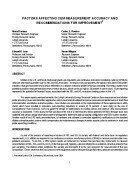Air Monitoring
FACTORS AFFECTING CEM MEASUREMENT ACCURACY AND RECOMMENDATIONS FOR IMPROVEMENT
Oct 03 2014
Author: Nenad Sarunac, Carlos E. Romero, Edward K. Levy, Harun Bilirgen on behalf of CEM
ABSTRACT
Utilities in the U.S. with fossil-fired power plants are required to use continuous emissions monitoring systems (CEMs) to measure and report quantities such as NOx and SO2 emissions. Among its many components, the typical, most used CEM system includes a flue gas flow meter and a device referred to as a dilution extractive probe for flue gas sampling. Numerous studies have pointed to positive measurement bias errors in these devices, which can be as high as 20 percent in some cases. Over-reporting represents the potential for financial losses associated with the NOx and SO2 emissions trading system in the U.S.
This paper reports work performed by the Lehigh University Energy Research Center on flow measurement and dilution probe accuracy issues and describes approaches which have been developed to improve measurement performance of stack flow instrumentation and dilution extractive probes. Case studies are presented on the implementation of these approaches to utility stacks which have resulted in emissions over-reporting reductions in excess of 15 percent. A case study on the use of Computational Fluid Dynamics (CFD) to guide the design of modifications to existing stacks and improve CEM measurement accuracy is illustrated. In this study, the flue gas flow at the exit of a heat recovery steam generator (HRSG) through stack was modeled and various design alternatives were investigated to determine optimum piping configuration and CEM system location. Another result of the ERC work, presented here, is hardware and software (a correction algorithm) modifications to the standard dilution extractive probe system which compensates for instantaneous changes in probe accuracy due to variations in stack and probe operating conditions.
INTRODUCTION
As part of the process of reporting emissions of NOx and SO2 to comply with federal and state clean air regulatory requirements, U.S. utilities are required to use continuous emissions monitoring systems (CEMs) to measure and calculate mass pollutant emissions. To do this, a CEM system needs an instrument to measure flue gas flow rate, instruments to measure concentrations of NOx, SO2 and CO2 (or O2) in the flue gas and, typically, a device referred to as a dilution extractive probe for flue gas sampling. The dilution probe conditions the sample and transports it to the gas analyzers for measurement of flue gas composition. Errors arise from the inaccuracies in the equipment used to measure flue gas flow rates, pollutant concentrations and in the dilution probe system. Strict calibration procedures are used to reduce errors resulting from gas analyzer measurement accuracies. In some cases, corrections are introduced to reduce the effect of barometric pressure on certain analyzer readings.
Over the last several years, considerable attention has been given to the accuracy of CEM measurements. Power generation companies are concerned with meeting applicable measurement standards, as well as avoiding over-reporting emissions. Numerous studies1 reported evidence that the procedures specified in the EPA regulations for certifying the accuracies of flow monitors result in measured gas flow rates, which are higher than the actual values. This resulted in modifications to the EPA regulations, which permit utilities to use more accurate equipment and procedures for calibrating flow monitors. In the case of the dilution probe system, several investigators2 have reported on the limitations or inherent problems associated with the dilution probe, which result in positive measurement bias errors. These errors are caused by changes in stack conditions and dilution probe operating conditions. Changes in stack and probe operating conditions, result in changes in the extracted sample that are not compensated by the system’s components.
This paper reports work performed by the Energy Research Center (ERC) on flow measurement and dilution probe accuracy issues and describes approaches which have been developed to improve measurement performance of stack flow instrumentation and dilution extractive probes. The use of a computational tool to guide design indications of existing stacks and the investigation of alternatives for optimal CEM system location and configuration is also reported.
Digital Edition
AET 28.2 April/May 2024
May 2024
Business News - Teledyne Marine expands with the acquisition of Valeport - Signal partners with gas analysis experts in Korea Air Monitoring - Continuous Fine Particulate Emission Monitor...
View all digital editions
Events
Jul 30 2024 Jakarta, Indonesia
China Energy Summit & Exhibition
Jul 31 2024 Beijing, China
2024 Beijing International Coal & Mining Exhibition
Aug 07 2024 Beijing, China
IWA World Water Congress & Exhibition
Aug 11 2024 Toronto, Canada
Aug 25 2024 Stockholm, Sweden and online






.jpg)








